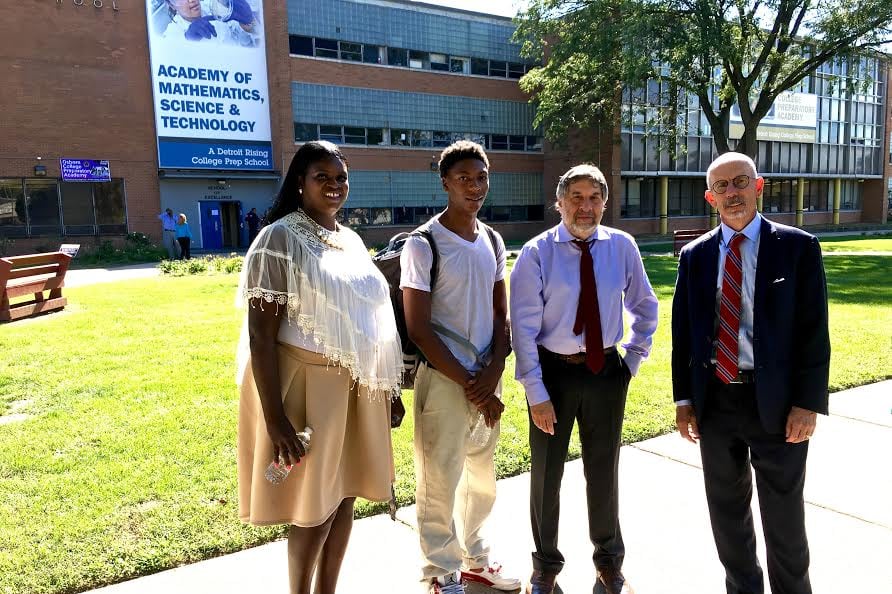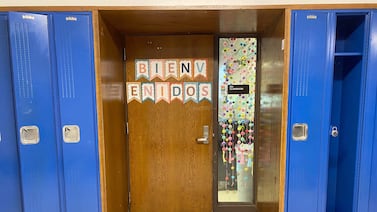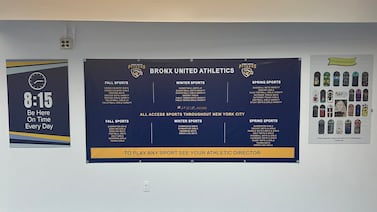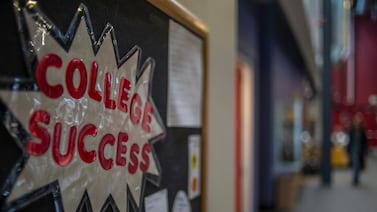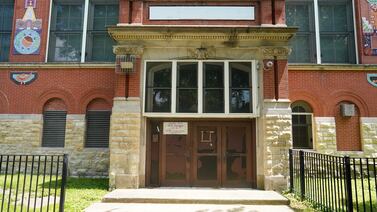When the Detroit “right-to-read” lawsuit was filed in 2016, it detailed conditions the plaintiffs said deprived “students of even a fighting chance.”
Remedies could be on the way, because Gov. Gretchen Whitmer announced early Thursday that a settlement had been reached with plaintiffs in the historic lawsuit, which sought to establish a right to literacy. The Sixth Circuit Court of Appeals ruled last month in favor of the plaintiffs.
The settlement included $2.7 million that will go to the Detroit school district and $280,000 that will go to the plaintiffs. An additional $94.4 million for literacy programs would go to the district, but the state legislation would need to approve.
The lawsuit was filed on behalf of students who at the time attended two schools in the Detroit school district and two charter schools, all of which have either closed or undergone major transformations. The lawsuit also refers to the district’s Marion Law Academy, which at the time of the lawsuit was part of the defunct Education Achievement Authority, a system that was run by the state for some of the worst-performing schools in Detroit.
Here, adapted from a 2016 Chalkbeat story, we highlight some of the allegations included in the 136-page lawsuit. The allegations are based on statements from students and teachers.
Hamilton Academy (a charter school that closed in 2019)
- Many students had a vocabulary of only a couple hundred words. Some students couldn’t sound out letters.
- The middle school science classes at Hamilton are currently taught by a paraprofessional who states that she does not understand the material and cannot lead classroom experiments.
- In the 2015-16 school year, the seventh- and eighth-grade math teacher left several weeks after the start of school year due to frustration with large class sizes and lack of support. He was temporarily replaced by a paraprofessional and then a special education teacher. Eventually, the highest performing eighth-grade student was asked to take over teaching both seventh- and eighth-grade math, while the paraprofessional remained in the room to assist with classroom management. This student taught both math classes for a month.
- After a Hamilton student was kidnapped and murdered, his classmates were not provided any opportunity to grieve. No additional counselors were brought in, and the teachers were not offered any support or training on how to speak with the students about the tragedy. Instead, on the day the police found the boy’s body, the only school-wide reaction was an announcement by loudspeaker to remind the students, who were using their phones to share details about what happened and to communicate their grief, that cell phones were not allowed at school.
- Temperatures of over 100 degrees caused students and teachers to vomit and pass out during the first week of school.
- The playground equipment — which is designed for 2-5 year olds, although the school served children ages 5-14 — is frequently broken. One of the playground slides was disconnected at the base so it shifted around, and the other had cracks with sharp pieces of plastic sticking out. Multiple students had sliced or otherwise injured themselves while playing.
- It was not uncommon for meals to feature moldy bread and expired milk. The students knew not to drink out of the water fountains, which are frequently infested with cockroaches and maggots, and the teachers and principal would bring in bottled water they purchased themselves.
- Students found bullets, used condoms, sex toys, and dead vermin on the playground, although teachers tried to arrive early to clean the playground themselves.
Cody Medicine and Community Health (previously was among three schools that operated in the Cody High building; now there is just one school)
- Many of the students struggled when called upon to read aloud, with some stumbling over monosyllabic words. Yet the few instructors originally designated as reading interventionists, which was insufficient in number, were required to cover teacher vacancies in other classrooms.
- There was no meaningful training in literacy intervention available, even when requested by teachers. Plaintiff Jaime R. was in an English language arts course in ninth grade during which the class spent a large part of the year going paragraph by paragraph through a single novel, which has a third-grade reading level.
- There were multiple students who didn’t speak or write fluently in English, yet there were no English language learner teachers at the school. When a family of Iraqi refugees sought to register their daughter, their community school, the district attempted to transfer the child to a school over 25 miles away because it could not support her English language needs. The teachers ultimately relied on other students who spoke Arabic to assist the English language learner students.
Marion Law Academy (was a Detroit district school for years, until the Education Achievement Authority was formed. It remained there until 2017, when the EAA was disbanded)
- At Marion Law Academy, inexperienced teachers used Google to search the internet for lesson plans the night before class, and many paid out of their own pockets to obtain lesson plans online.
- Classrooms become so crowded that a teacher who managed to obtain chairs for all 42 students had to pack them together so tightly that a left-handed student could not sit next to a right-handed student. When a teacher was absent and no short-term substitute was available, classes were frequently combined. That could leave one teacher with as many as 60 students.
- The school lacked teaching resources. Textbooks, library books, and other curricular materials were thrown away at the beginning of the 2012-2013 school year when the school opened as an EAA school. The materials were trashed as part of a plan to switch to digital learning. But the new digital platform was ineffective, lacked existing instructional materials, and was abandoned in the 2015-16 school year. Administrators told teachers at Law that they were expected to buy their own supplies.
- At Law, several classrooms flooded. In one fourth-grade classroom, a leaking hole in the ceiling created what students called “the lake,” and the teacher surrounded the area with yellow caution tape after multiple requests for repairs were ignored.
Experiencia Preparatory Academy (a charter school that had closed by the time the lawsuit was filed)
- There were no certified English language learner teachers for long stretches of the school’s three years of operation. In the upper grades, about 20 of the approximately 80 students were English learners, but the English language class available to them covered the same elementary phrases for two years, regardless of the skill level of the individual students.
- Plaintiff Esmeralda V. — who was more comfortable speaking Spanish than English — was frequently called upon to assist her Spanish-speaking classmates by summarizing the material for them in Spanish. Some students relied on Google Translate in order to teach themselves English, although many EL students did not have access to the Internet outside of school.
- Textbooks at Experiencia were damaged and many years out of date, with taped spines and ripped and missing pages. The computers at the school were frequently broken, and when they did work, the Internet connectivity was so poor that they were nearly unusable. The third floor of the building technically had a library, but there was no librarian and students were not permitted to access the library or check out books without a teacher escort. Most of the time, the library remained locked.
Osborn Academy of Mathematics (one of the schools that used to operate in the Osborn High School building; there is now only one school)
- One class had 42 students but only 32 desks. Another classroom had 52 students but only 37 chairs and fewer desks. The overcrowding also significantly exacerbated the extreme heat at many points during the year.
- At the Osborn schools, fire exits are frequently locked and chained to prevent unauthorized individuals from entering from the street. During the 2015-16 school year, a fire broke out in the school and students were given no notice to evacuate because the Osborn fire alarm system failed.
- At Osborn MST, urine frequently leaks out of the men’s room and soaks the carpet in the hallway, causing the hallway to smell for days.


